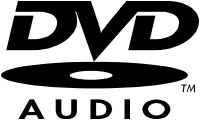DVD-Audio facts for kids
 |
|
|---|---|
| Media type | Optical disc |
| Encoding | Meridian Lossless Packing or uncompressed LPCM |
| Capacity | up to 8.5 GB |
| Read mechanism | 640 nm wavelength semiconductor laser |
| Standard | DVD Books, Part 4, DVD-Audio Book, DVD Audio Recording Book |
| Developed by | DVD Forum |
| Usage | Audio storage |
| Extended from | DVD |
DVD-Audio is a special type of audio disc. It is similar to a regular CD, but it was designed to offer even better sound quality. Many people believed DVD-Audio would replace CDs because of its advanced features.
However, DVD-Audio never became very popular. One reason was that the players needed to play these discs were expensive and hard to find. Also, most people felt that the sound quality of traditional CDs was already excellent. Scientists have even shown that CDs provide the best possible sound quality for human ears.
One cool feature of DVD-Audio is its support for surround sound. This means the sound can come from different directions, making you feel like you are right in the middle of the music. While regular CDs don't usually offer surround sound, DVD-Audio discs often do.
Contents
How DVD-Audio Discs Work
DVD-Audio discs can store sound in many different ways. They support various "sample rates," which means how many times per second the sound is measured. Some common rates are 44.1 kHz (like a CD) and 96 kHz (like a DVD movie). They can also record sound with more detail, using 16, 20, or 24 bits. More bits mean a clearer sound.
Surround Sound on DVD-Audio
When you listen to music in surround sound, it feels like the sound is all around you. DVD-Audio discs can play surround sound at sample rates up to 96 kHz. If the sound is recorded at even higher rates, it can only be in mono (one speaker) or stereo (two speakers).
Protecting the Music
DVD-Audio discs use a special code, called 56-bit encryption, to protect the music on them. This is like a secret lock that keeps the audio safe. However, this lock has been figured out by experts.
Playing DVD-Audio Discs
Sometimes, a DVD-Audio disc might also have regular video content on it. This helps the disc work with DVD players that are only made for movies. Unlike some other music discs, DVD-Audio discs cannot be played on a standard CD player. You need a special DVD-Audio player or a compatible DVD player to enjoy them.
See also
 In Spanish: DVD-Audio para niños
In Spanish: DVD-Audio para niños

